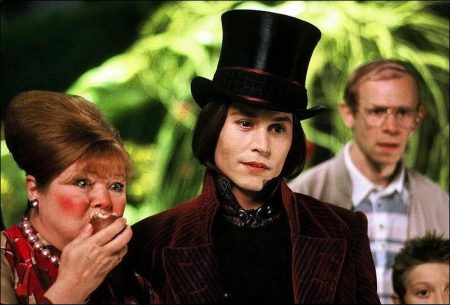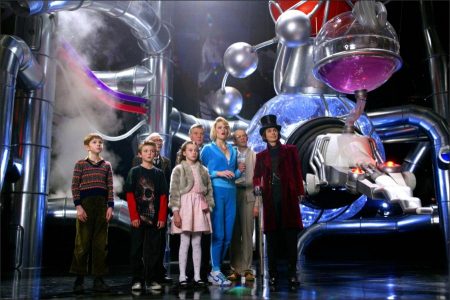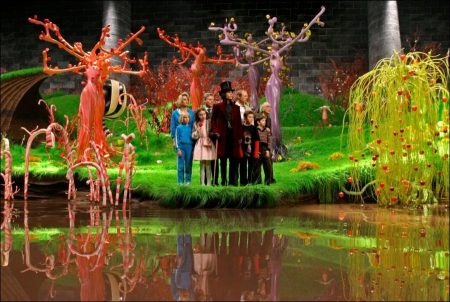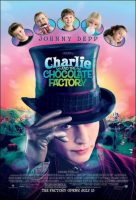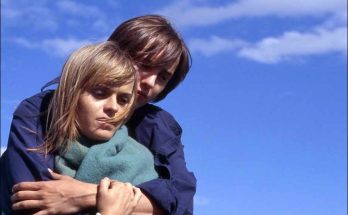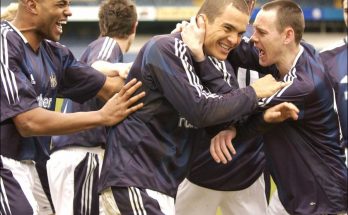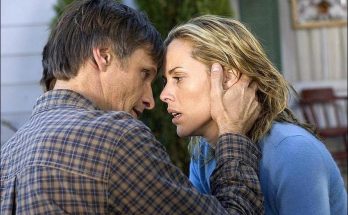Charlie and the Chocolate Factory. Once inside the factory walls, offers Zanuck, “the children discover an entire world complete with a chocolate waterfall and chocolate river, edible trees and unbelievable machinery that only a mind such as Roald Dahl, interpreted by a mind such as Tim Burton, could possibly imagine. It’s fantasy, it’s fun, it’s completely outrageous and awe-inspiring. You don’t know where to look first.”
In creating the landscape of Wonka’s world, the filmmakers began at the source, to tap into, as Burton describes, “the textural, visceral quality of Dahl’s images and the scope. We tried to keep as true to the book as possible in creating specific places like the nut room and the TV room. Still, there is a lot of room for interpretation, which is the wonderful thing about doing an adaptation like this. Each room has its own flavor and possibilities.
“Instead of relying too much on blue or green screen effects we tried to build as much of the settings as possible,” the director continues. “We built most of the sets at 360 degrees so the actors are really enveloped in the environment.”
It was a huge compliment to the production when Felicity Dahl first stepped onto the Pinewood soundstages to examine the work in progress and enthusiastically declared, “it’s magical! I know that if Roald had seen it, he would have loved it. He would have said this is exactly what he had in mind.”
What Dahl had in mind proved no small task to construct. His Chocolate Factory contained cavernous rooms wherein whole environments were housed, like the one in which the Oompa-Loompas both worked and lived beside a chocolate waterfall and flowing chocolate river, where candy cane trees grew, giant peapods produced Wonka gobstoppers and even the grass was edible.
Unwieldy one-of-a-kind machinery pumped out Wonka’s fanciful confections while in other rooms equally outlandish contraptions were engaged in experiments to create even more exotic and delicious candies. Traveling through the factory meant navigating the river in a translucent boat of spun pink sugar or climbing aboard a glass elevator that sped not only up and down but, as the text declares, “sideways and longways and slantways and any other way you can think of,” including blasting up through the roof at rocket speed.
Production utilized seven stages and much of the back lot at Pinewood Studios in the UK, including the famous James Bond stage, which houses one of the largest soundstage pools in the world. Says Production Designer Alex McDowell (Art Directors Guild Award winner for The Terminal and nominee for Minority Report; Fight Club, The Crow), “We pretty much took over the studio lot – lock, stock and barrel.”
Because Burton preferred to accomplish as much as possible with practical effects, a great deal of what appears on screen was created physically with prosthetic and special effects coordinated by Special Effects Supervisor Joss Williams, whose previous collaboration with Burton, Sleepy Hollow, earned him a BAFTA nomination.
“When those reached their natural limitations, we took over in the digital realm,” says Visual Effects Supervisor Nick Davis (AFI and BAFTA nominee for Harry Potter and the Sorcerer’s Stone), who oversaw the integration of advanced motion capture technology and CGI “for anything that could not be achieved practically on set. It was a collaborative effort among multiple departments and it all began with Tim, who had all these ideas and kept producing drawings to show us what he wanted.”
Early pre-planning and ongoing communication were key, since images morphed instantly from one process to another and back again in the same scene. Sets were built and used simultaneously on the back lot, in the computer and in 24-scale miniature models. “I spent a lot of time in pre-production working with conceptual artists and Nick Davis, so that everything was cohesive,” says McDowell. “From a design standpoint, there’s no difference between a physical and a virtual set and Charlie was a film that required a total design sensibility, from Oompa- Loompa hand props to the vast CG world that the boat and elevator travel through.”
Citing the example of the spun-sugar boat, he says, “the boat travels from the chocolate river into a white tunnel rapids ride. It’s a physical entity in the chocolate room but inside the tunnel that’s a fully CG environment. The boat goes onto a gimbal platform and is shot against a blue screen. It also has to be replicated and made in CGI. You have actors in the physical boat with prosthetic Oompas and CG actors with scaled-down Oompa-size CG versions of Deep Roy at the oars in the CG boat. I spent a couple months in close collaboration with the CG and miniatures companies, designing alongside the 3D and physical model makers.”
The Chocolate River
“The most important thing Tim said about the chocolate river,” recalls Joss Williams, was “`make it look good enough to eat,’ and that’s how we approached it, to look as yummy as possible.”
For the effects supervisor, that meant managing “viscosity, looks, color testing and safety issues,” not to mention logistics, quantity, transportation and storage.
The option of making the chocolate off-site and bringing it in via tanker was quickly dismissed, as calculations estimated a need for 40 tanker trucks. It seemed a better plan to manufacture and store the stuff on site. As for mixing it, conventional cement mixers proved inadequate. They needed a vessel that could mix three or four tons at a time, which they found, ironically, in the form of commercial vats designed for mixing toothpaste, that could blend as many as 12 tons at a time and store 20,000.
Altogether, production required a constant supply of more than 200,000 gallons of flowing chocolate; approximately 32,000 for the waterfall and 170,000 for the river, which measures 180 feet long by 25-to-40-feet wide, and is nearly 3 feet at its deepest point.
Without revealing the exact recipe, Williams acknowledges experimenting with mixtures of water and dietary cellulose, with various food dyes to achieve the right look and texture. “Color to the eye is different than color on film,” he explains, “so we tested through a whole pattern of shades to get exactly the right one.” Once prepared, the mixture was constantly cleaned and tested daily by a local laboratory “to make sure it was safe for the company to work with and eat.” Only half-joking, he adds, “we had to keep the bugs down to an acceptable level. There’s about as many bugs in it as you’d find in an airline sandwich.”
For the scene in which Augustus Gloop tumbles into the chocolate river and is subsequently sucked up through an intake pipe to another part of the factory, young Philip Wiegratz was slowly conditioned to the unusual sensation of floundering in melted chocolate. “We started Philip in a small tank in the workshop” says Williams. “Then we tested him in the fat suit that he wears as Augustus; it couldn’t be too buoyant or he’d float, and it couldn’t absorb the mixture and become an enormous weight around him. Probably worst of all, from his perspective, was that once this stuff gets into your ears you can’t hear very well.”
As the scene progresses where the camera cannot follow, the practical set gives way to a CG rendering of events, with a virtual Gloop being squeezed into the narrow space and then spat upwards through the tube – all of which involved Nick Davis and his team with their own issues of color and viscosity, not to mention duplicating “liquid dynamics” in the computer.
Taking a big-picture approach, Davis maintains that, “software can help you break down the physics. You can plug in the known parameters – melt speeds, drip speeds, pour speeds, mass and weight, which helps a lot. But at the end of the day there’s always a human, artistic side to it, where you just look at it and say `hmmm, that’s too fast’ or `that’s too shiny.’”
Charlie and The Chocolate Factory (2005)
Directed by: Tim Burton
Starring: Johnny Depp, Freddie Highmore, David Kelly, AnnaSophia Robb, Helena Bonham Carter, Jordan Fry, Julia Winter, Philip Wiegratz, Christopher Lee, Franziska Troegner
Screenplay by: John August
Production Design by: Alex McDowell
Cinematography by: Philippe Rousselot
Film Editing by: Chris Lebenzon
Costume Design by: Gabriella Pescucci
Set Decoration by: Peter Young
David Allday: François Audouy, Matthew Gray, Sean Haworth, ,James Lewis, Andy Nicholson, Kevin Phipps, Stuart Rose, Leslie Tomkins
Music by: Danny Elfman
MPAA Rating: PG-13 for quirky situations, action and mild language.
Distributed by: Warner Bros. Pictures
Release Date: July 15, 2005
Views: 140
